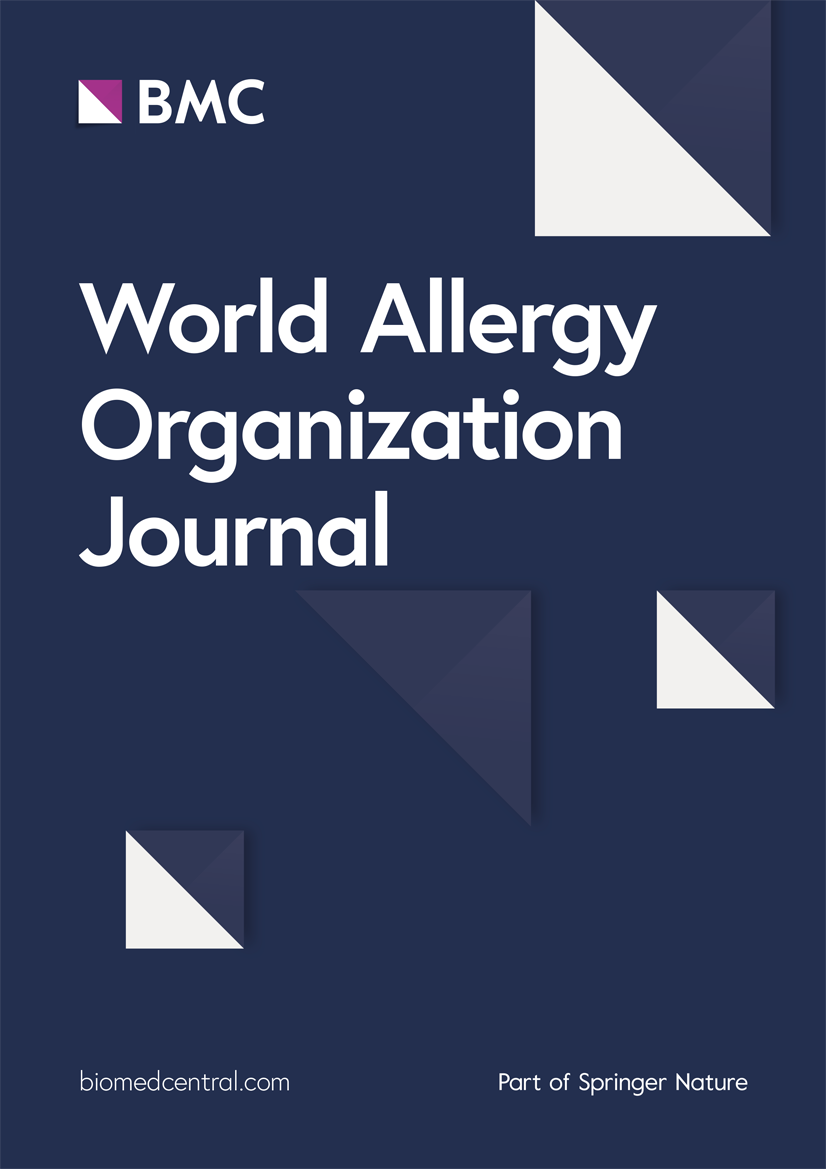嗜酸性粒细胞性食管炎和过敏易感性:一项系统回顾和荟萃分析
IF 4.3
2区 医学
Q2 ALLERGY
引用次数: 0
摘要
嗜酸性粒细胞性食管炎(EoE)是一种2型辅助性T (Th2)细胞免疫介导的胃肠道疾病。越来越多的证据支持过敏病因是EoE的潜在机制,但EoE与特应性之间的相关性程度仍不明确。因此,我们进行了一项荟萃分析,以评估和比较EoE和非EoE患者之间共存的常见特应性疾病的发生率。方法通过电子数据库和文献综述检索描述EoE和非EoE患者特应性疾病共存率的研究。根据临床和病理评价诊断为EoE。偏倚风险采用改良的纽卡斯尔-渥太华量表进行评估。随机效应模型用于分析。定量结果以比值比(OR)和95%置信区间(CI)表示。进行亚组分析和敏感性分析以探索和确定研究之间的异质性。发表偏倚采用Egger检验,并采用漏斗图可视化。结果共纳入27项研究,纳入病例1831例,对照组2982例。57.2%的EoE患者并发特应性疾病。与非EoE对照相比,EoE患者更容易合并特应性疾病(OR = 3.56, 95% CI: 2.27 ~ 5.59, I2 = 78%),包括哮喘(OR = 2.43, 95% CI: 1.94 ~ 3.06, I2 = 29%)、变应性鼻炎(OR = 5.39, 95% CI: 3.29 ~ 8.84, I2 = 78%)、特应性皮炎(OR = 2.46, 95% CI: 1.89 ~ 2.30, I2 = 12%)和食物过敏(OR = 4.93, 95% CI: 3.96 ~ 6.14, I2 = 0%)。通过亚组和敏感性分析探索和确定异质性来源,大多数亚组估计与主要发现一致。未发现显著的发表偏倚。结论EoE患者更易并发特应性疾病,有利于EoE患者的过敏素质。临床医生应警惕有上消化道症状的过敏患者的EoE。然而,EoE与特应性疾病之间的因果关系尚未揭示,仍有待探索。本文章由计算机程序翻译,如有差异,请以英文原文为准。
Eosinophilic esophagitis and allergic susceptibility: A systematic review and meta-analysis
Background
Eosinophilic esophagitis (EoE) is a type 2 helper T (Th2) cell immune-mediated gastrointestinal disease. Accumulating evidence has supported allergic etiology as an underlying mechanism for EoE, but the magnitude of the correlation between EoE and atopy remains ambiguous. Hence, we performed a meta-analysis to evaluate and compare the rate of co-existing common atopic diseases between EoE and non-EoE patients.
Methods
We searched through electronic databases and reference lists of review articles for studies describing co-existing rates of atopic diseases in EoE and non-EoE patients. EoE was diagnosed based on clinical and pathological evaluations. Risk of bias was assessed using the modified Newcastle-Ottawa Scale. Random-effects models were used for analyses. Quantitative results were presented as odds ratio (OR) and 95% confidence interval (CI). Subgroup analyses and sensitivity analyses were performed to explore and to identify heterogeneity across studies. Publication bias was examined by Egger's test and visualized by funnel plots.
Results
Altogether, 27 studies containing 1831 cases and 2982 controls were enrolled. 57.2% of EoE patients had co-existing atopic disease. Patients with EoE were more likely to comorbid with atopic diseases (OR = 3.56, 95% CI: 2.27 to 5.59, I2 = 78%), including asthma (OR = 2.43, 95% CI: 1.94 to 3.06, I2 = 29%), allergic rhinitis (OR = 5.39, 95% CI: 3.29 to 8.84, I2 = 78%), atopic dermatitis (OR = 2.46, 95% CI: 1.89 to 2.30, I2 = 12%) and food allergy (OR = 4.93, 95% CI: 3.96 to 6.14, I2 = 0%) than non-EoE controls. Heterogeneity sources were explored and identified via subgroup and sensitivity analyses, with the majority of subgroup estimates aligning with the primary findings. No significant publication bias was detected.
Conclusions
Our findings suggest that EoE patients are more likely to comorbid atopic diseases, favoring the allergic diathesis of EoE. Clinicians should be alert for EoE in allergic patients having upper gastrointestinal symptoms. However, the causality between EoE and atopic diseases was not revealed and remains to be explored.
求助全文
通过发布文献求助,成功后即可免费获取论文全文。
去求助
来源期刊

World Allergy Organization Journal
Immunology and Microbiology-Immunology
CiteScore
9.10
自引率
5.90%
发文量
91
审稿时长
9 weeks
期刊介绍:
The official pubication of the World Allergy Organization, the World Allergy Organization Journal (WAOjournal) publishes original mechanistic, translational, and clinical research on the topics of allergy, asthma, anaphylaxis, and clincial immunology, as well as reviews, guidelines, and position papers that contribute to the improvement of patient care. WAOjournal publishes research on the growth of allergy prevalence within the scope of single countries, country comparisons, and practical global issues and regulations, or threats to the allergy specialty. The Journal invites the submissions of all authors interested in publishing on current global problems in allergy, asthma, anaphylaxis, and immunology. Of particular interest are the immunological consequences of climate change and the subsequent systematic transformations in food habits and their consequences for the allergy/immunology discipline.
 求助内容:
求助内容: 应助结果提醒方式:
应助结果提醒方式:


